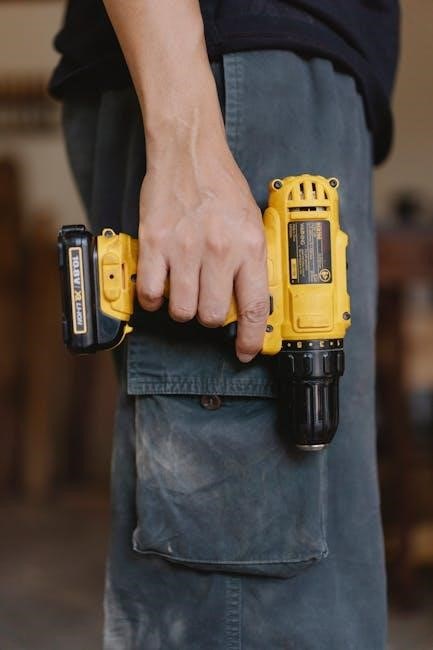Manual and electric chokes are carburetor systems used to regulate air-fuel mixture‚ with manual chokes requiring driver control and electric chokes automatically adjusting based on engine temperature conditions always.
Overview of Choke Systems
Choke systems are essential components of carburetors‚ responsible for regulating the air-fuel mixture in an engine. The primary function of a choke system is to restrict the airflow to the engine‚ allowing for a richer air-fuel mixture‚ which is necessary for starting and warming up the engine. There are two main types of choke systems: manual and electric. Manual choke systems rely on a mechanical linkage to control the choke valve‚ while electric choke systems use an electric motor to adjust the choke valve. Both systems have their own advantages and disadvantages‚ and the choice between them depends on various factors‚ including personal preference‚ driving conditions‚ and engine specifications. A thorough understanding of choke systems is crucial for optimal engine performance‚ fuel efficiency‚ and overall vehicle maintenance. Choke systems play a critical role in ensuring a smooth and efficient engine operation‚ and their proper functioning is essential for a vehicle’s overall performance.
Importance of Choosing the Right Choke
Choosing the right choke system is crucial for optimal engine performance‚ fuel efficiency‚ and overall vehicle maintenance. The correct choke system can significantly impact the engine’s ability to start‚ idle‚ and run smoothly. A mismatched choke system can lead to decreased performance‚ reduced fuel efficiency‚ and increased emissions. Additionally‚ a properly chosen choke system can also affect the engine’s lifespan‚ as an incorrectly calibrated system can cause engine damage over time; Furthermore‚ the right choke system can also improve the overall driving experience‚ providing a smoother and more responsive acceleration. It is essential to consider factors such as engine type‚ driving conditions‚ and personal preference when selecting a choke system. By choosing the right choke system‚ drivers can ensure their vehicle runs efficiently‚ effectively‚ and reliably‚ which is critical for both everyday driving and high-performance applications‚ and can also help to prevent potential engine problems.

Manual Choke Operation
Manual choke systems operate through mechanical linkages‚ cables‚ and levers‚ allowing drivers to control air-fuel mixture and engine performance manually always with ease and precision every time.
How Manual Chokes Work
Manual chokes work by using a mechanical linkage‚ typically a cable‚ to connect a control inside the vehicle to a choke valve in the carburetor. When the driver activates the control‚ the cable pulls or pushes the choke plate‚ partially obstructing the carburetor’s air intake. This restriction of air flow creates a richer air-fuel mixture‚ which is necessary for cold engine starts. As the engine warms up‚ the driver can adjust the choke to allow more air into the engine‚ creating a leaner air-fuel mixture. The manual choke system requires the driver to manually adjust the choke to achieve the optimal air-fuel mixture‚ allowing for more control over engine performance. The system is relatively simple and easy to understand‚ making it a popular choice for those who prefer a more hands-on approach to engine management. The manual choke system is also relatively inexpensive and easy to maintain.
Advantages of Manual Chokes
Manual chokes have several advantages‚ including simplicity and ease of use. They provide a hands-on approach to engine management‚ allowing drivers to have direct control over the air-fuel mixture. This can be beneficial for drivers who prefer a more traditional driving experience. Manual chokes are also relatively inexpensive and easy to maintain‚ making them a cost-effective option. Additionally‚ manual chokes can be calibrated for more performance‚ using bigger jets and rods‚ which can result in increased power and efficiency. They are also a good option for drivers who live in areas with mild climates‚ where the engine is less likely to be exposed to extreme temperatures. Overall‚ manual chokes offer a reliable and straightforward solution for engine management‚ making them a popular choice for many drivers. They are also a good option for those who prefer a more mechanical and less complex system.

Electric Choke Operation
Electric chokes automatically adjust air-fuel mixture based on engine temperature conditions always using sensors and actuators to control airflow and fuel delivery precisely and efficiently every time.
How Electric Chokes Work
Electric chokes work by using a temperature-sensitive sensor to monitor the engine’s temperature and adjust the air-fuel mixture accordingly. This sensor sends a signal to an electric actuator‚ which then controls the choke valve to regulate airflow. The electric actuator is typically powered by the vehicle’s electrical system and is designed to provide a precise and consistent control over the air-fuel mixture. As the engine warms up‚ the sensor detects the increase in temperature and sends a signal to the actuator to open the choke valve‚ allowing more air to flow into the engine. This process is continuous and automatic‚ eliminating the need for manual adjustment. The electric choke system is designed to provide optimal engine performance and fuel efficiency‚ and is often preferred for its convenience and reliability. The system is also relatively simple and easy to maintain‚ making it a popular choice for many vehicle owners.

Advantages of Electric Chokes
Electric chokes have several advantages‚ including convenience and ease of use. They automatically adjust the air-fuel mixture‚ eliminating the need for manual adjustment. This makes them ideal for drivers who want a hassle-free experience. Electric chokes also provide optimal engine performance and fuel efficiency‚ as they are designed to regulate airflow based on engine temperature. Additionally‚ electric chokes are relatively simple and easy to maintain‚ making them a popular choice for many vehicle owners. They are also less prone to human error‚ as the automatic adjustment eliminates the possibility of incorrect manual adjustment. Overall‚ electric chokes offer a reliable and efficient way to regulate airflow‚ making them a great option for drivers who value convenience and performance. The electric choke system is also designed to work seamlessly with other engine components‚ providing a smooth and efficient driving experience. This makes them a great choice for drivers who want a trouble-free experience.

Comparison of Manual and Electric Chokes
Manual and electric chokes differ in operation and functionality‚ with distinct benefits and drawbacks‚ affecting vehicle performance and driver experience always and in many different situations and conditions.
Key Differences Between Manual and Electric Chokes
The primary difference between manual and electric chokes lies in their operation and control mechanisms. Manual chokes require the driver to manually adjust the air-fuel mixture by pulling a lever or cable‚ whereas electric chokes automatically adjust the mixture based on engine temperature. This fundamental difference affects the overall performance and drivability of the vehicle. Electric chokes tend to provide a more precise and consistent air-fuel mixture‚ resulting in improved fuel efficiency and reduced emissions. On the other hand‚ manual chokes offer a more hands-on experience and can be preferred by drivers who enjoy having direct control over the engine. Additionally‚ manual chokes are often simpler in design and less prone to mechanical failures compared to electric chokes‚ which rely on complex electronic systems. Overall‚ the choice between manual and electric chokes depends on the driver’s preferences and the specific requirements of the vehicle.
Calibration and Performance Differences
Calibration plays a crucial role in determining the performance of manual and electric chokes. The calibration process involves adjusting the air-fuel mixture to achieve optimal engine performance‚ which can vary depending on the type of choke used. Manual chokes can be calibrated to provide a richer or leaner air-fuel mixture‚ depending on the driver’s preferences and the specific requirements of the vehicle; Electric chokes‚ on the other hand‚ are calibrated to provide a precise and consistent air-fuel mixture based on engine temperature and other factors. The performance differences between manual and electric chokes are noticeable‚ with manual chokes often providing a more responsive and aggressive throttle response. However‚ electric chokes tend to provide better fuel efficiency and reduced emissions‚ making them a popular choice for drivers who prioritize economy and environmental sustainability. Overall‚ the calibration and performance differences between manual and electric chokes are significant and can impact the overall driving experience.